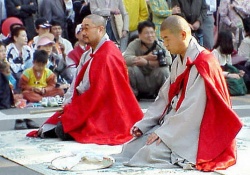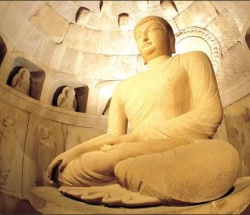Sautrantika Theory of Perception
Dharmottara (847 A.D.), a commentator of Dharmakirti's [Footnote ref 245] (about 635 A.D.) Nyayabindu, a Sautrantika logical and epistemological work, describes right knowledge (samyagjnana) as an invariable antecedent to the accomplishment of all that a mandesires to have (samyagjnanapurvika sarvapurusarthasiddhi) [Footnote ref 246].
When on proceeding, in accordance with the presentation of any knowledge, we get a thing as presented by it we call it right knowledge. Right knowledge is thus the knowledge by which one can practically acquire the thing he wants to acquire (arthadhigati). The process of knowledge, therefore, starts with the perceptual presentation and ends with the attainment of the thing represented by it and the fulfilment of the practical need by it (arthadhigamat samapta pramanavyaparah).
Thus there are three moments in the perceptual acquirement of knowledge: (
1) the presentation,
(2) our prompting in accordance with it, and
(3) the final realization of the object in accordance with our endeavour following the direction of knowledge.
Inference is also to be called right knowledge, as it also serves our practical need by representing the presence of objects in certain connections and helping us to realize them. In perception this presentation is direct, while in inference this is brought about indirectly through the linga (reason).
Knowledge is sought by men for the realization of their ends, and the subject of knowledge is discussed in philosophical works only because knowledge is sought by men. Any knowledge, therefore, which will not lead us to the realization of the object represented by it could not be called right knowledge.
All illusory perceptions, therefore, such as the perception of a white conch-shell as yellow or dream perceptions, are not right knowledge, since they do not lead to the realization of such objects as are presented by them.
It is true no doubt that since all objects are momentary, the object which was perceived at the moment of perception was not the same as that which was realized at a later moment. But the series of existents which started with the first perception of a blue object finds itself realized by the realization of other existents of the same series (niladau ya eva santanah paricchinno nilajnanena sa eva tena prapitah tena nilajnanam pramanam) [Footnote ref 247].
When it is said that right knowledge is an invariable antecedent of the realization of any desirable thing or the retarding of any undesirable thing, it must be noted that it is not meant that right knowledge is directly the cause of it; for, with the rise of any right perception, there is a memory of past experiences, desire is aroused, through desire an endeavor in accordance with it is launched, and as a result of that there is realization of the object of desire.
Thus, looked at from this point of view, right knowledge is not directly the cause of the realization of the object. Right knowledge of course directly indicates the presentation, the object of desire, but so far as the object is a mere presentation it is not a subject of inquiry. It becomes a subject of inquiry only in connection with our achieving the object presented by perception.
Perception (pratyaks'a) has been defined by Dharmakirtti as a presentation, which is generated by the objects alone, unassociated by any names or relations (([[[kalpana]]) and which is not erroneous (kalpanapodhamabhrantam) [Footnote ref 248]. This definition does not indeed represent the actual nature (svarupa) o perception, but only shows the condition which must be fulfilled in order that anything may be valid perception.
What is meant by saying that a perception is not erroneous is simply this, that it will be such that if one engages himself in an endeavour in accordance with it, he will not be baffled in the object which was presented to him by his perception (tasmadgrahye arthe vasturupe yadaviparyastam tadabhrantamiha veditavyam}.
It is said that a right perception could not be associated with names (kalpana or abhilapa). This qualification is added only with a view of leaving out all that is not directly generated by the object.
A name is given to a thing only when it is associated in the mind, through memory, as being the same as perceived before. This cannot, therefore, be regarded as being produced by the object of perception.
The senses present the objects by coming in contact with them, and the objects also must of necessity allow themselves to be presented as they are when they are in contact with the proper senses.
But the work of recognition or giving names is not what is directly produced by the objects themselves, for this involves the unification of previous experiences, and this is certainly not what is presented to the sense .
In all illusory perceptions it is the sense which is affected either by extraneous or by inherent physiological causes. If the senses are not perverted they are bound to present the object correctly.
Perception thus means the correct presentation through the senses of an object in its own uniqueness as containing only those features which are its and its alone (svalaksanam). The validity of knowledge consists in the sameness that it has with the objects presented by it .
But the objection here is that if our percept is only similar to the external object then this similarity is a thing which is different from the presentation, and thus perception becomes invalid. But the similarity is not different from the percept which appears as being similar to the object. I
t is by virtue of their sameness that we refer to the object by the percept (taditi sarupyam tasya vas'at) and our perception of the object becomes possible. It is because we have an awareness of blueness that we speak of having perceived a blue object. The relation, however, between the notion of similarity of the perception with the blue object and the indefinite awareness of blue in perception is not one of causation but of a determinant and a determinate (vyavasthapyavyavasthapakabhavena).
Thus it is the same cognition which in one form stands as signifying the similarity with the object of perception and is in another indefinite form the awareness as the percept (tata ekasya vastunah kincidrupam pramanam kincitpramanaphalam na virudhyate).
It is on account of this similarity with the object that a cognition can be a determinant of the definite awareness (vyavasthapanaheturhi sarupyam), so that by the determinate we know the determinant and thus by the similarity of the sense-datum with the object {pramana) we come to think that our awareness has this particular form as "blue" .
If this sameness between the knowledge and its object was not felt we could not have spoken of the object from the awareness (sarupyamanubhutam vyavasthapanahetuh). The object generates an awareness similar to itself, and it is this correspondence that can lead us to the realization of the object so presented by right knowledge [Footnote ref 249].



